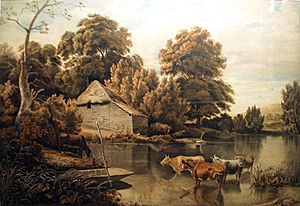William Havell facts for kids
William Havell (born 1782, died 1857) was an English artist. He was famous for painting beautiful landscapes. William was part of the well-known Havell family of artists. He also helped start the Society of Painters in Watercolours.
Contents
William Havell's Early Life and Art

William Havell was born in Reading, England. He was one of fourteen children. His father, Luke Havell, was a drawing teacher. Luke also ran a small shop to help support his large family.
William went to Reading Grammar School. His father taught art there. At first, his father worried about William becoming an artist. He knew it could be hard to make money. But William showed great talent. So, his father supported him. He even paid for William to go on a sketching trip to Wales. This trip helped William learn a lot.
In 1804, William sent his first paintings to the Royal Academy. These included views of Carnarvon Castle and the Nant Ffrancon valley in Wales. That same year, he became a founding member of the Society of Painters in Watercolours.
In 1807, William moved to Ambleside in the Lake District. He stayed there for about two years. He studied the mountain scenery and created many wonderful artworks. Later, in 1813, he left the Watercolour Society. However, he could still show his art at their exhibitions. He also showed his work at the Royal Academy in 1812 and 1814.
Travels and Later Career
In 1816, William Havell was painting a series of pictures. These showed beautiful views of British homes. Around this time, he got a job as a draughtsman. He was to travel with Lord Amherst on a trip to China.
However, William had a disagreement with an officer on the ship. Because of this, he left his job. He then sailed to India in 1817. He stayed in India until 1825. There, he found good work painting portraits and landscapes.
When he returned to England, he rejoined the Watercolour Society. But his art was not as popular as it used to be. After a while, he stopped showing his work there. He then started painting with oils instead of watercolours.
In 1827, Havell traveled to Italy with another artist, Thomas Uwins. They visited famous cities like Florence, Rome, and Naples. He often showed his paintings at the Royal Academy. His subjects were mostly from Italy. But he also painted scenes from Wales, Westmoreland, and China. He also exhibited his art at the British Institution and Suffolk Street.
William Havell's paintings were very good. They had clear and soft colors. But people did not buy them much. He also lost his money when a bank in India failed. Because of this, he received help from the Royal Academy's Turner Fund.
William Havell passed away in Kensington, London, on December 16, 1857. He was buried at Kensal Green Cemetery.
The Havell Family of Artists
William was not the only artist in his family. Three of his brothers were also well-known artists.
- George Havell (died around 1839) painted animals. He also tried engraving and sculpture.
- Edmund Havell sometimes showed his art at the Royal Academy. He took over his father's job as a drawing teacher in Reading. Edmund's son, Edmund Havell the younger (born 1819), also became a famous artist.
- Frederick James Havell (1801–1840) was the third brother. He worked on different types of engraving. He also experimented with early photography.
William Havell's Artistic Legacy
William Havell was one of the best early watercolour painters. He helped improve this art form a lot. His oil paintings were not very popular when he was alive. However, they are now highly valued.
Between 1804 and 1857, he showed many landscapes. He exhibited 103 paintings at the Royal Academy. He also showed 42 at the British Institution and 32 at Suffolk Street. People described his works as having "good composition." They also noted his skill in showing the "effect of sunshine." His oil paintings were praised for being "well-composed and arranged."



